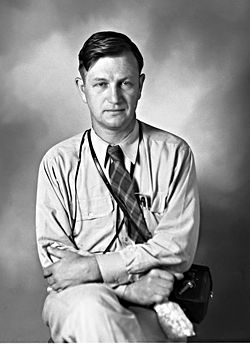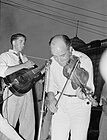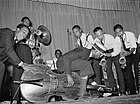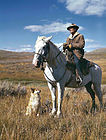Russell Lee (photographer)
Russell Lee | |
|---|---|
 Russell Lee, c. 1942 | |
| Born | July 21, 1903 Ottawa, Illinois, United States |
| Died | August 28, 1986 (aged 83) Austin, Texas, United States |
Russell Lee (July 21, 1903 – August 28, 1986)[1][2] was an American photographer and photojournalist, best known for his work for the Farm Security Administration (FSA). His images documented the ethnography of various American classes and cultures.
Life
The son of Burton Lee and wife Adeline Werner, Lee grew up in Ottawa, Illinois and went to the Culver Military Academy in Culver, Indiana for high school. He earned a degree in chemical engineering from Lehigh University in Bethlehem, Pennsylvania.[3]
He gave up a position as a chemist to become a painter. Originally he used photography as a precursor to his painting, but soon became interested in photography for its own sake, recording the people and places around him. Among his earliest subjects were Pennsylvanian bootleg mining and the Father Divine cult.[4]
In the fall of 1936, during the Great Depression, Lee was hired for the federally sponsored Farm Security Administration (FSA) photographic documentation project of the Franklin D. Roosevelt administration. He joined a team assembled under Roy Stryker, along with Dorothea Lange, Arthur Rothstein and Walker Evans. Stryker provided direction and bureaucratic protection to the group, leaving the photographers free to compile what in 1973 was described as "the greatest documentary collection which has ever been assembled."[3] Lee created some of the iconic images produced by the FSA, including photographic studies of San Augustine, Texas in 1939, and Pie Town, New Mexico in 1940. Over the spring and summer of 1942, Lee was one of several government photographers to document the eviction of Japanese Americans from the West Coast, producing over 600 images of families waiting to be removed and their later life in various detention facilities.[5]
After the FSA was defunded in 1943, Lee served in the Air Transport Command (ATC), during which he took photographs of all the airfield approaches used by the ATC to supply the Armed Forces in World War II. He worked for the United States Department of the Interior (DOI) in 1946 and 1947, helping the agency compile a medical survey in the communities involved in mining bituminous coal. He created over 4,000 photographs of miners and their working conditions in coal mines.[6] In 1946, Lee completed a series of photos focused on a Pentecostal Church of God in a Kentucky coal camp.[7]
While completing the DOI work, Lee also continued to work under Stryker, producing public relations photographs for Standard Oil of New Jersey.[3]
In 1947 Lee moved to Austin, Texas and continued photography. In 1965 he became the first instructor of photography at the University of Texas.[3]
Legacy
In addition to the materials at the University of Louisville, other important collections of Lee's work are held by the New Mexico Museum of Art,[8] Wittliff collections, Texas State University[9] and the Dolph Briscoe Center for American History at the University of Texas at Austin.[10] In 2016, Lee Elementary, a school in the Austin Independent School District, was renamed Russell Lee Elementary in honor of the photographer, replacing the original namesake, Robert E Lee.[11][12]
Selected photographs
-
Conversation at the General Store, near Jeanerette, Louisiana, 1938
-
Cajun fiddler, Crowley, Louisiana, 1938
-
Hot orchestra performs specialty number, Crowley, LA
-
Resting farmer, Crowley, LA
-
Shop window
-
Segregated facilities, Oklahoma City, OK, 1939
-
Drawing water from a hand pump, Oklahoma City
-
Old man born in slavery displays the horn formerly used to call slaves, Texas
-
Llano de San Juan church, New Mexico, 1940
-
Serving food in Pie Town
-
Quilt, Pie Town, New Mexico
-
Shasta Dam under construction, 1942
-
Montana shepherd
-
U.S. Airman
-
Snake handling in a Kentucky church, 1946
References
- ^ "Russell Lee Photographic Collection". Explore UK. University of Kentucky. Retrieved July 19, 2018.
- ^ "Russell Lee Biography". University of Texas at Austin. Retrieved July 22, 2018.
- ^ a b c d Hurley, F. Jack. "RUSSELL LEE: "F. Jack Hurley on Russell Lee" (1973)". ASX. Retrieved February 13, 2012.
- ^ "Russell Lee". The People's America Farm Security Administration Series. Indiana University Art Museum. Retrieved February 13, 2012.
- ^ Young, Morgen. "Russell Lee". Densho Encyclopedia. Retrieved August 28, 2014.
- ^ Hurley, F. Jack. "Lee, Russell Werner". Texas State Historical Association. Retrieved February 12, 2012.
- ^ Lee, Russell. "Faith healing, speaking in tongues, and taking up serpents in the name of God!". American Ethnography Quasimonthy. American Ethnography. Retrieved February 13, 2012.
- ^ "Russell Lee Online". Artcyclopedia.com. Retrieved June 18, 2013.
- ^ Russell Lee Photographs at The Wittliff Collection, Texas State University, San Marcos, TX
- ^ "Russell Lee Photograph Collection at the Dolph Briscoe Center for American History". Lib.utexas.edu. Retrieved June 18, 2013.
- ^ Barnes, Michael (August 17, 2016). "As students return, a primer on Russell Lee, one school's new namesake". Austin American Statesman. Retrieved August 14, 2018.
- ^ Taboada, Melissa B. (September 1, 2017). "Austin trustees revive talk of renaming schools with Confederate ties". Austin American Statesman. Retrieved August 14, 2018.
External links
- Biographical Sketch of Lee
- Online Russell Lee collection
- Spanish Speaking People of Texas (Series of Russell Lee Photographs from the Russell Lee Photograph Collection)
- He Was a Camera (Texas Monthly Magazine Article)
- Article about Lee at the University of Texas website
- Flickr Photostream: LOC's Archive of Russell Lee's FSA Photos
- Wittliff Collection Southwestern and Mexican Photography, Texas State University
- "Captured: America in Color from 1939–1943", Denver Post PLog, July 26, 2010.
- Brisco – A Guide to the Russell Lee Photograph Collection, University of Texas
- Russell Lee's FSA Photos of Pie Town, New Mexico Museum of Art
















